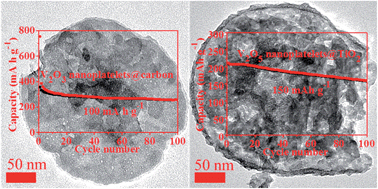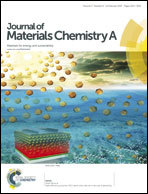Design of vanadium oxide core–shell nanoplatelets for lithium ion storage†
Abstract
Vanadium oxides are promising electrode materials for lithium ion batteries, V2O5 as cathode and V2O3 as anode. However, both of them suffer from poor cycling stability and low rate performance. Reducing their particle size to the nanometer range and fabricating core–shell structures represent two versatile strategies to improve their electrochemical performance. In this work, we developed a solution route to round V2O3 nanoplatelets with diameters of about 400 nm and thicknesses of about 20 nm. They can be successfully transformed into hierarchical V2O5, into V2O3@amorphous carbon core–shell structures with tunable carbon layer thickness and into hierarchical V2O5@TiO2 core–shell structures under full preservation of the 2-dimensional morphology. As an anode material, the carbon composite exhibits higher specific capacity and better cycling stability and rate performance in comparison to the pure V2O3 nanoplatelets. They can deliver a highly reversible capacity of 261 mA h g−1, 200 mA h g−1, 165 mA h g−1 and 122 mA h g−1 at a current density of 100 mA g−1, 400 mA g−1, 800 mA g−1, and 1600 mA g−1, respectively. As a cathode material, the V2O5 nanoplatelets@TiO2 cycled at 0.5 C (1 C = 300 mA g−1) for 100 times deliver a high initial discharge capacity of 211 mA h g−1 with a high Coulombic efficiency of 99.1%. The fading rate of 0.24% per cycle is less than half of the decaying rate of pure V2O5 nanoplatelets, indicating better cycling stability for the composite structures.


 Please wait while we load your content...
Please wait while we load your content...